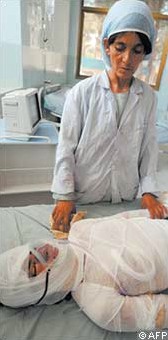By Jon Boone in Herat

In 2006 the United Nations Development Programme said that 106 Afghan women had deliberately burnt themselves.
more photos
The hospital that Amina had been checked into a few days before is, by Afghan standards, one of the best in the country, built with international money, staffed by foreign- trained doctors and kitted out with modern equipment. She could not hope for better treatment.
But her chances of survival were not good.
Dosed with drugs and swaddled in bandages, she had only a small portion of her face visible in the emergency ward she shared with four other patients. The blistered skin on her face merely hinted at the horrendous burns covering much of the rest of her body.
While in other parts of the specialist burns hospital in Herat there were a few men and a couple of children who had had nasty accidents, about half its patients were women who had deliberately doused themselves in petrol and set themselves alight.
Mohamad Harif Jalali, a doctor at the hospital, says when women are admitted with 80 or 90 per cent burns there is usually little doubt their woundshave been self-inflicted.
The hospital shies away from giving many details about how they came by their extensive injuries but the story told by Gulran, admitted four days earlier, is apparently typical.
Dr Jalali says Gulran had been treated like a second-class citizen, unable to get on with a new woman who entered the household after her father took a second wife.
The modern burns facility is by some way the most impressive building in the Herat central hospital compound, boasting sterilised wards, western standard facilities and 34 beds. The operating theatre is kept busy by the constant demand for skin grafts. But as Marie Jose Brunez from HumaniTerra International, a French organisation that helps to run the facility and train the Afghan doctors, points out, you have to have enough skin intact for the procedure to work.
“For women with the most severe burns there is little the hospital can do, other than making them comfortable with painkillers and waiting for them to die,” she says.
Many of the women are ignorant of the full horrors of burning to death and the lingering end that awaits them, or have been misled by Iranian films, she says.
Neighbouring Iran exercises a powerful cultural grip over Herat. “Iranian movies that feature self-immolation are very popular here, they make it look easy. The girls think they just have to put petrol on themselves and it will all be over in a second,” Dr Brunez says.
Other experts say self-immolation is favoured because of the ready availability of flammable liquids in Afghan houses.

Afghan woman Raza Ahmadi poses showing her burn scars on her face during an interview with an AFP reporter in Herat on July 31, 2008. Ahmadi sustained burns to 45 percent of her body after setting herself alight a year ago to escape pressure from her father to marry. Afghan women are in a subordinate position in society, where conservative Islamic laws and traditions dictate what a woman is allowed to do in a male dominated world. Forced marriages, domestic violence, poverty and lack of access to education are said to be some of the main reasons for self immolation. (Photo: AFP/Getty Images)
Either way, some women’s organisations are reluctant to fund big publicity campaigns to raise awareness for fear that it will just give women ideas about how they can kill themselves.
Reliable figures on self-immolation in Afghanistan are thin on the ground. In 2006 the United Nations Development Programme said that 106 Afghan women had deliberately burnt themselves.
But Charlemagne Gomez, who wrote a report last year for the German women’s charity Medica Mondiale, says the real figure is likely to be much higher.
“We can only measure reported incidents of when women are admitted to hospital. But often the families will refuse to take them to hospital because they do not want to bring dishonour on the family. And of course if they die, no one will know about it; it will just be hushed up.”
Opinions are divided on the reason women in Herat are more likely than their counterparts in the south, or the capital Kabul, to take such a drastic step. One theory is that, compared with the rest of the country, women in the city enjoy a relatively high level of education and are more likely to resent forced married life.
But Ms Gomez says it is in fact a countrywide problem and is merely better reported in Herat.
One pattern that has emerged with reasonable clarity from the available data is that most are young women between the ages of 16 and 19. They have not had to put up with years of abuse but have recently, and unwillingly, gone to live away from their family as part of an arranged marriage.
“It is not untypical to find a girl, an 18-year-old girl, who has become the second wife of an 80-year-old husband,” says Dr Bunez. “What sort of a life is that? They get beaten by their husband [and] mistreated by the mother-in-law and they have no way to talk to their families.”



